Learning2gether Episode 389
Vance Stevens was with colleagues on the CALL-IS Webcasting Team from Tuesday, March 27 through Friday March 30 helping the team mount webcasts from the international 2018 TESOL Conference in Chicago.
I (Vance) posted two Learning2gether events from the most recent TESOL conference in Chicago in which I myself took part:
- Learning2gether episode 387 – Preparing Teachers to Engage Learners with EVO Minecraft MOOC- https://learning2gether.net/2018/03/28/tesol-2018-chicago-preparing-teachers-to-engage-learners-with-evo-minecraft-mooc/
- Learning2gether episode 388 – The Best of EVO at TESOL, Chicago, 2018 – https://learning2gether.net/2018/03/28/the-best-of-evo-at-tesol-chicago-2018/
The first webcast was mounted by the presenters themselves, whereas the latter was a part of the CALL-IS schedule that was placed in convention bags for all who attended the conference, also available online at https://call-is.org/ev/schedule.php
CALL-IS announced that its webcasting team would be webcasting selected presentations from TESOL 2018 in Chicago according to the schedule here:
http://callis2018.pbworks.com/

To do our webcasting, the CALL-IS Webcasting team used, for the second year in a row, Open Broadcasting Software. This technique was the brainchild of last year’s CALL-IS webcasting coordinator Abe Reshad, who trained the rest of us in use of the software and set up a number of YouTube channels for us.
We used three of these channels this year.
CALL IS: Technology Showcase
https://www.youtube.com/channel/UChnWYx1ZGtHnzzpV5t98J4Q
CALL IS: Electronic Village
https://www.youtube.com/channel/UCWzUQsJbiBWU2xT6P5Qm9kw
CALL IS: Webcasting Team
https://www.youtube.com/channel/UC5j3UKImiBHm6ddOI-4WHzg
This year the webcasting team was coordinated by Jennifer Meyer who went in the course of a little over a year from rank newbie to train herself in skills sufficient to competently lead the team at the conference this year.
We documented our learning journeys through these developments in a short history of CALL-IS webcasting over the years, and in an abbreviated report published in the CALL-IS newsletter.
- Bauer-Ramazani, C., Meyer, J., Reshad, A., Stevens, V., & Watson, J. (2017). A brief history of CALL-IS webcasting in the new millennium. TESL-EJ, Volume 21, Number 1, Available: http://www.tesl-ej.org/wordpress/issues/volume21/ej81/ej81int/. Also available at: http://tesl-ej.org/pdf/ej81/int.pdf; pp. 1-16 in pdf.
- An excerpted version of the above article was published as
Bauer-Ramazani, C., Meyer, J., Reshad, A., Stevens, V., & Watson, J. (2017). A brief history of CALL-IS webcasting in the new millennium. On CALL: The Newsletter of the Computer Assisted Language Learning Interest Section. n.p. Available: http://newsmanager.commpartners.com/tesolcallis/issues/2017-09-12/2.html
In addition, I made the following presentations and blog posts last year in conjunction with developing my own understanding of this new technique:
- March 22, 2017 – I presented on “Configure Encoders, Stream YouTube Live, and Record Lesson Materials On-the-Fly” on site at the TESOL Seattle conference, March 22-24, 2017
https://docs.google.com/presentation/d/12KL1390JLzBsopdsMLMi6ZHNC23CEzT2biNp0mCOV3M/edit?usp=sharing - March 22 through March 24 – Vance Stevens and Learning2gether assisted CALL-IS with streaming from 2017 Seattle TESOL
https://learning2gether.net/2017/03/24/learning2gether-assists-call-is-with-streaming-from-2017-seattle-tesol/
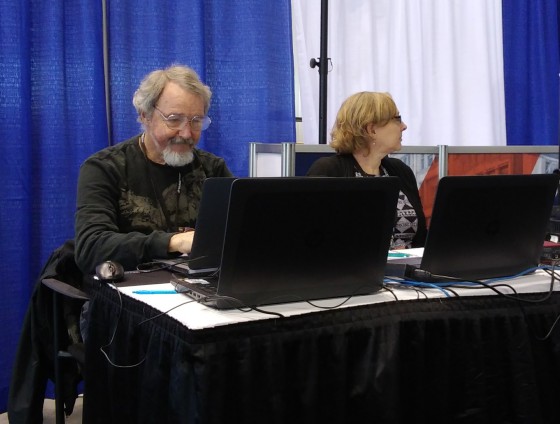
Jennifer Meyer drives OBS while Vance Stevens monitors the stream and text chat at the Technology Fair webcasting “studio booth” – picture by Juan Soto
I took on the job as sole roving reporter for the team at the conference this year. Mentored in this by James May, I used the Chameleon 3rd party app last year to make a few videos on my iPad, spontaneously shot as I moved around the Electronic Village, pointed my iPad, and pressed record. I tested the same app on Tuesday while we were setting up the room the evening before going live the following day, and uploaded this video to our Webcasting team channel:
- Setting up for streaming in the Technology Fair area of the Exhibition Hall at TESOL 2018 Chicago: https://youtu.be/sZ_XE4MigbY
Later James explained to me that this function was now taken over directly through YouTube/Live, so working through the YouTube app, I made the following videos from events taking place in the Electronic Village.
Roving reporter webcasts from the CALL-IS Electronic Village
These videos were streamed using Cameleon Live, https://www.cameleon.live/. When checked on Oct 8, 2018 the videos were found linked on YouTube but appearing like you see below, so I have de-linked them from here. But try, they could bounce back:
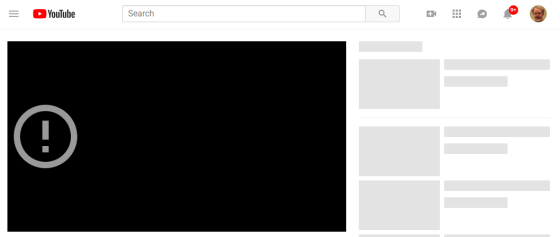
- 1:30-2:20 In the ELECTRONIC VILLAGE, Technology Fair Classics: Gaming with Trace Effects – https://youtu.be/z_z9BYSMROE
- 11:00-11:50 In the ELECTRONIC VILLAGE Technology Fair, Tom Robb and mReader – https://youtu.be/MzYcc64jtRc

Tom Robb explaining mReader – Picture by Juan Soto
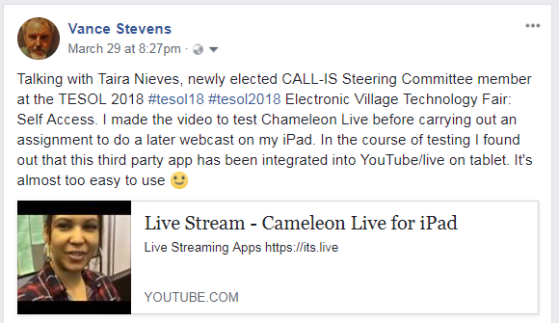
- Roving Reporter cameos – https://youtu.be/lt9QeCncsfU – this one no longer works on You Tube. The ones below were working on Oct 8, 2019
- Just testing, https://youtu.be/JeUS3citnB0
- Interviewing new CALL-IS steering committee member Taira Nieves,
https://youtu.be/TZm3oOXCNgI - Interviewing Maria Tomeho-Palermino, then roving,
https://youtu.be/EF6gR5QskGc

Christel Brodie surveys her audience from the podium at the Education Standard 2e, Teacher Training, Technology, Apps, and Digital Resources panel presentation. Christel’s presentation was interrupted several times by PA from a raffle being conducted elsewhere in the Exhibition Hall. In fairness, the rafflers turned down the volume when we reached them and explained the situation, but webcasting from such a space posed challenges for discerning audiophiles. – picture by Vance Stevens

Heather Benucci and Ellen Dougherty webcast Christel’s presentation, controlling the OBS Studio software and monitoring stream health, respectively. You can see how OBS allows you to queue scenes on the left side of the studio panel, where you can make manipulations and adjustments to them, while streaming what’s on the right. The queued view can be transitioned to the stream (with a variety of effects) at the press of a button between the panels. – picture by Vance Stevens
Webcasting Team output from the CALL-IS Technology Fair
As the webcasting happened over the three days of the conference, March 28-30, I updated the wiki at http://callis2018.pbworks.com with the YouTube URLs as they happened.
Here are the webcasts made by the team in the CALL Technology Fair over the course of these three days
Wednesday March 28
- 9:00-10:20 On the Cutting Edge: Graduate Student Panels
– https://youtu.be/20U7iyuN1Js - 10:30-12:20 Best of EVO 2018
– https://youtu.be/HUEOyNB1wEI - 1:00-2:45 InterSection CALL-IS and VDMIS: Is Video Making It a SMALL World?
– https://youtu.be/A6ouVWHVOZw - 3:00-4:45 InterSection TEIS and CALL-IS: Teacher Education Standard 2e, Teacher Training, Technology, Apps, and Digital Resources
– https://youtu.be/3hPuVcve2zo - 5:00-6:30 CALL-IS Open Meeting in Room: N135
– https://youtu.be/NjQ3vVKUQkQ
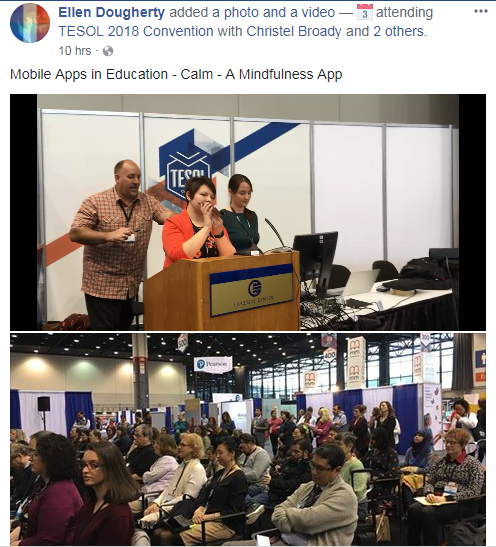
Webcasting team member Ellen Dougherty’s post to Facebook captured a standing room audience for the Mobile Apps for Education panel, as presenters demonstrated the calming effects of their Mindfulness app
Thursday March 29
- 9:30-11:15 InterSection CALL-IS with ICIS and Globetrotters Forum: Addressing Intercultural Awareness and CALL Importance in a Globetrotter Environment
– https://youtu.be/XaxVcUK2S9I - 11:30-12:15 TESOL Sponsor Presentation Harnessing the Power of Technology for Assessment: CAL Test Platform
– https://youtu.be/qKuovW8WpA0 - 12:30-1:15 TESOL Sponsor Presentation: VOXY: Voxy Big Data in Language Education: Integrating Personalized Out-of-Class Work with In-Class Activities
– https://youtu.be/6smOGkM2_88 - 2:00-3:30 Mobile Apps for Education
– https://youtu.be/ZdO13aXol38 - 3:45-5:00 Hot Topic: The Positive and Negative Use of OER: The Real Picture . . .
– https://youtu.be/s47PEzIFXs0
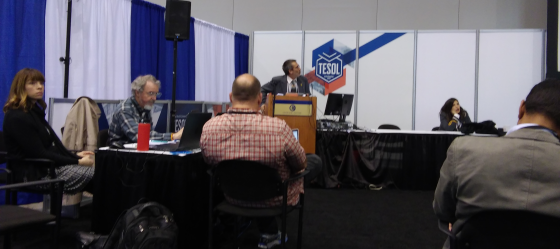 Webcasting team members Heather Benucci, Vance Stevens, and James May (back to camera) project Rick Rosenberg’s presentation in the OER panel to the world at large – picture by Juan Soto
Webcasting team members Heather Benucci, Vance Stevens, and James May (back to camera) project Rick Rosenberg’s presentation in the OER panel to the world at large – picture by Juan Soto
Friday March 30
- 9:00-10:20 On the Cutting Edge: Graduate Student Panels
– https://youtu.be/WMYp0qz4XKo - 10:30-12:20 Developers’ Showcase
– https://youtu.be/xIQkKRRXAJ4 - 1:00-2:45 CALL-IS Academic Session Blended Learning: Creating (or Promoting) Effective Tech-Supported Teaching/Learning Spaces
– https://youtu.be/KS2jcKBUvuQ
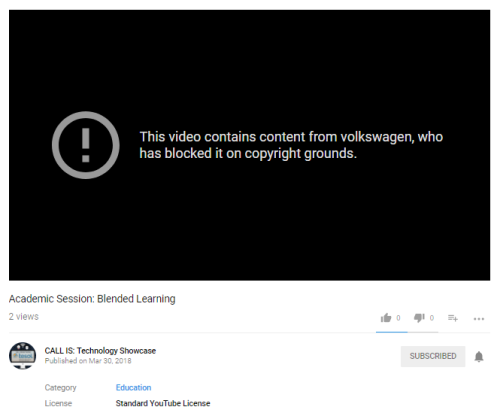
Regarding the latter video, it was flagged for copyright violation by Volkswagen and taken down. If we can recover the video (do we have access to it ourselves?) we might remove the offending material and try re-uploading it.
Reactions and Reflections

twitter.com/nelliemuller/status/984703436385079296
Webcasts from TESOL Chicago, March 2018
The CALL-IS (computer-assisted language learning interest section) in TESOL has been webcasting informally from TESOL conferences since the turn of the century, but the initiative is almost becoming institutionalized now. Normally CALL-IS is given a presentation room at each conference to set up as it likes with webcasting equipment, but at this past conference in Chicago the webcasting was done from an area in the Exhibition Hall at the conference, openly, in other words.
Last word
James May produces the definitive CALL-IS Technology Fair view
https://twitter.com/professorjmay/status/979060534313177089
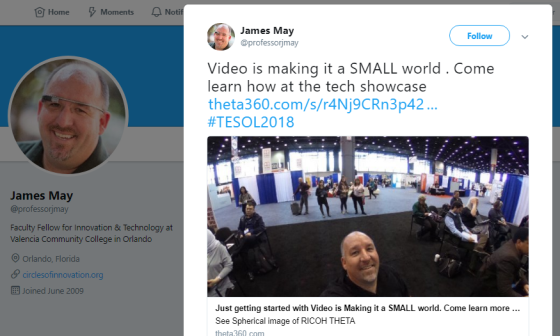
Check out the panoramic view, very cool:
Just getting started with Video is Making it a SMALL world. Come learn more about how to use video with your students #tesol18 #theta360 – Spherical Image – RICOH THETA
Coda
TESOL does not promote the existence of CALL-IS webcasts on its TESOL Inc. website. In order to find them you have to (know to) visit a wiki maintained by the webcast team in CALL-IS, http://callis2018.pbworks.com/
Whereas CALL-IS in TESOL make a valiant effort to stream a portion of the conference out to live audiences, IATEFL does a truly impressive job. And it’s officially promoted by the conference organizers and The British Council.
See the next episode in this podcast series for more information on IATEFL’s approach to sharing its conferences with the world and profession at large:
https://learning2gether.net/2018/04/13/and-now-for-something-completely-different-iatefl-webcasting-from-2011-through-brighton-2018/
Scooped It!
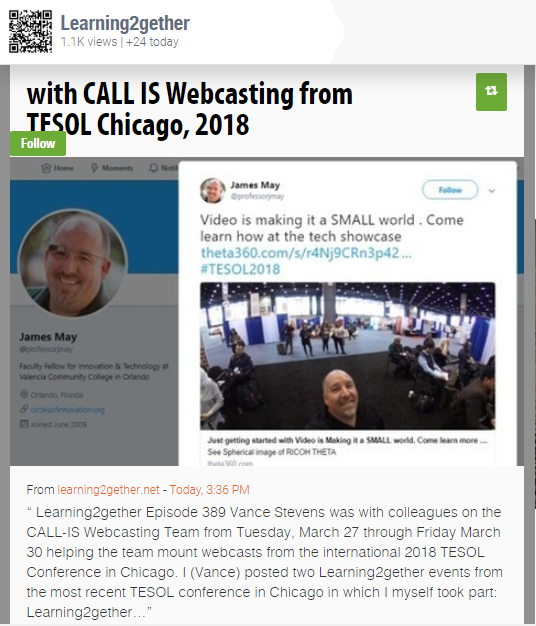
Youtube generally allows you to remove the section that’s been violated. We can also hide it using editing tools. I use Screencast-o-matic to edit MP4s.
Thanks for the advice. I guess the owner of the channel has to make a request to .. to what? How can we get the video? It was recorded from the live stream, so our only copy was removed by YouTube. OBS allows you to make a copy of your stream on the computer you’re using if you set it up to do that, but I doubt that setting was invoked, or even if the computer belonged to one of us, it may have been provided by the tech team at the conference.
Pingback: And now for something completely different: IATEFL Webcasting from 2011 through Brighton 2018 | Learning2gether